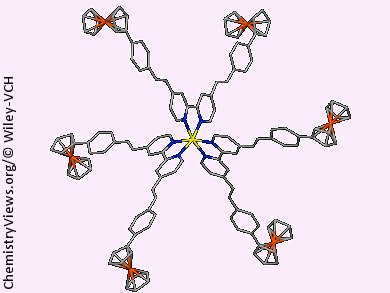Organic nonlinear optical (NLO) materials attract considerable attention for their potential application in areas such as advanced telecommunications and biological imaging. Molecules containing transition metals are also of interest because these provide greater structural diversity and scope for the development of multifunctional optical materials.
Benjamin Coe, University of Manchester, UK, and colleagues at the California Institute of Technology, USA, University of Leuven, Belgium, Wrocław University of Technology, Poland, and Universidad de Zaragoza-CSIC, Spain, have combined two successful branches of organotransition-metal NLO research to achieve pronounced quadratic and cubic NLO behavior in polymetallic assemblies. A series of new complexes with six ferrocenyl (Fc) groups connected to ZnII or CdII tris(2,2′-bipyridyl) cores has been synthesized.
These new chromophores are unusual in combining very large quadratic and cubic NLO effects in structures featuring multiple redox-switchable transition-metal centres. The good crystallizing ability of these chromophores is an attractive feature with regards to potential NLO materials applications, and counter-anion metathesis may be used to modify packing arrangements of the complexes.
- Heptametallic, Octupolar Nonlinear Optical Chromophores with Six Ferrocenyl Substituents,
B. J. Coe, S. P. Foxon, M. Helliwell, D. Rusanova, B. S. Brunschwig, K. Clays, G. Depotter, M. Nyk, M. Samoc, D. Wawrzynczyk, J. Garín, J. Orduna,
Chem. Eur. J. 2013.
DOI: 10.1002/chem.201204453




